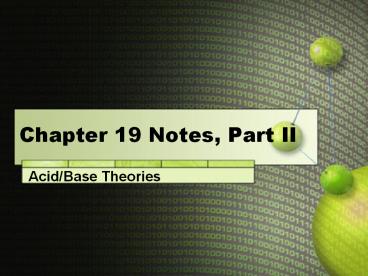Chapter 19 Notes, Part II - PowerPoint PPT Presentation
1 / 13
Title:
Chapter 19 Notes, Part II
Description:
Chapter 19 Notes, Part II Acid/Base Theories Three Definitions There are three ways to define acids and bases. This reflects the fact that science is always revising ... – PowerPoint PPT presentation
Number of Views:71
Avg rating:3.0/5.0
Title: Chapter 19 Notes, Part II
1
Chapter 19 Notes, Part II
- Acid/Base Theories
2
Three Definitions
- There are three ways to define acids and bases.
- This reflects the fact that science is always
revising itself.
3
Arrhenius Acids/Bases
- This is the definition of acids and bases we saw
earlier. - An acid is a chemical that gives off hydrogen
ions in solution. - A base is a chemical that gives off hydroxide
ions in solution.
4
Mono-, Di- and Triprotic
- Three ways to describe an acid
- Monoprotic-gives off one H in solution
- Diprotic-gives off two H
- Triprotic-gives off three H
5
Bronsted-Lowry Acids/Bases
- The Arrhenius definition is a good one, but does
not encompass everything that shows acidic/basic
qualities. - To account for this, Johannes Bronsted and
Thomas Lowry proposed a new idea.
6
Bronsted-Lowry Acids/Bases
- An acid is a hydrogen-ion (proton) donor.
- A base is a hydrogen-ion (proton) acceptor.
- A classic example is ammonia (NH3).
7
Conjugate Acids/Bases
- A conjugate acid is the particle that is formed
when a base gains a hydrogen ion. - A conjugate base is the particle that is formed
when an acid had donated a hydrogen ion.
8
Conjugate Acids/Bases
- A conjugate acid/base pair consist of two
substances related by the loss of a single
hydrogen ion.
9
NH3 H2O D NH4 OH-
- Which is the initial acid?
- Which is the base?
- What is the conjugate acid?
- What is the conjugate base?
10
HCl H2O D H3O Cl-
- Which is the initial acid?
- Which is the base?
- What is the conjugate acid?
- What is the conjugate base?
11
Amphoteric Substances
- Note that in one of the previous examples water
was acidic and basic in the other. - A substance that can act as an acid or a base is
called amphoteric.
12
Lewis Acids/Bases
- Lewis came up with a third definition of acids
and bases focusing on electrons. - A Lewis acid is a substance that can accept a
pair of electrons to form a covalent bond.
13
Lewis Acids/Bases
- A Lewis base is a substance that can donate a
pair of electrons to a covalent bond.































